What are the Mississippi River’s most snake-infested waters? The river holds great significance for the United States, playing a pivotal role in the nation’s rich history. Serving as an indispensable transportation route for the young nation, the Mississippi River played a pivotal role in fostering the country’s growth throughout the 19th century. The river defines the borders of two states: Wisconsin and Illinois, Iowa and Missouri. It also cuts across a total of 10 different states (Minnesota, Wisconsin, Iowa, Illinois, Missouri, Kentucky, Tennesee, Arkansas, Mississippi, and Louisiana). The Mississippi River is the second-longest river in the United States and is surpassed only by the Missouri River. It also ranks as the fourth-longest river in the world.
Four Mississippi River “Snake-Infested” Habitats
As it progresses downward to the Gulf of Mexico, the Mississippi River forms immaculate ecosystems that serve as homes and safe havens for a diverse range of wildlife species. In particular, it creates great habitats for many species of snakes to live and thrive. Snakes are most abundant in areas along the Mississippi River such as the delta region, wetlands and swamps, riverbanks, and backwaters. The following four ecosystems and their snake inhabitants cover the majority of the Mississippi River’s “snake-infested waters”.
Marshes
The Mississippi River’s creation of marshlands provides a sanctuary for an array of animal species. Marshes and swamps seem similar in our minds. But, while they both contain standing water there is a main differentiating factor between them: their plant life. The plants that thrive in each unique ecosystem can differ from each other. For example, swamps tend to possess deeper standing water, which persists for extended durations. Marshes have rich waterlogged soil that supports many different kinds of fauna and plant life, including all kinds of snakes!
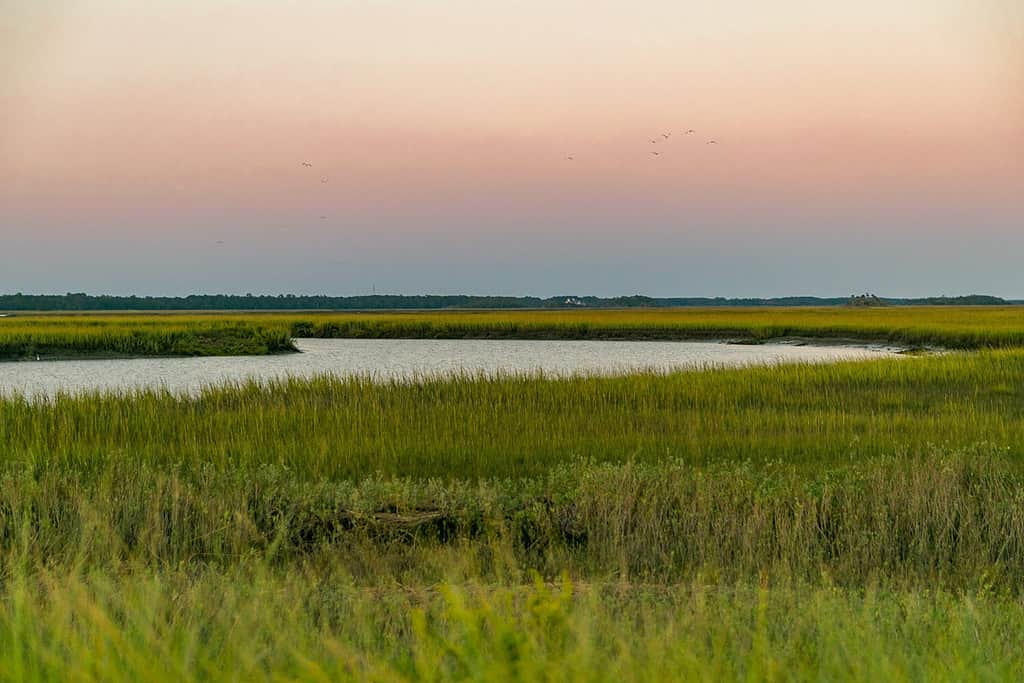
Many different types of water-loving snakes live in marshes along the Mississippi River.
©Elizabeth Foley/Shutterstock.com
Bottomland Hardwood Forests
From deer to mischievous raccoons, industrious beavers, and, of course, snakes, animals of all kinds harmoniously live amidst bottomland hardwood forests. In addition, bottomland hardwood forest woodlands offer sanctuary to a symphony of avian life, including enchanting songbirds, spirited woodpeckers, and birds of prey. A bottomland hardwood forest is a type of deciduous forest that thrives in floodplains alongside rivers and streams.
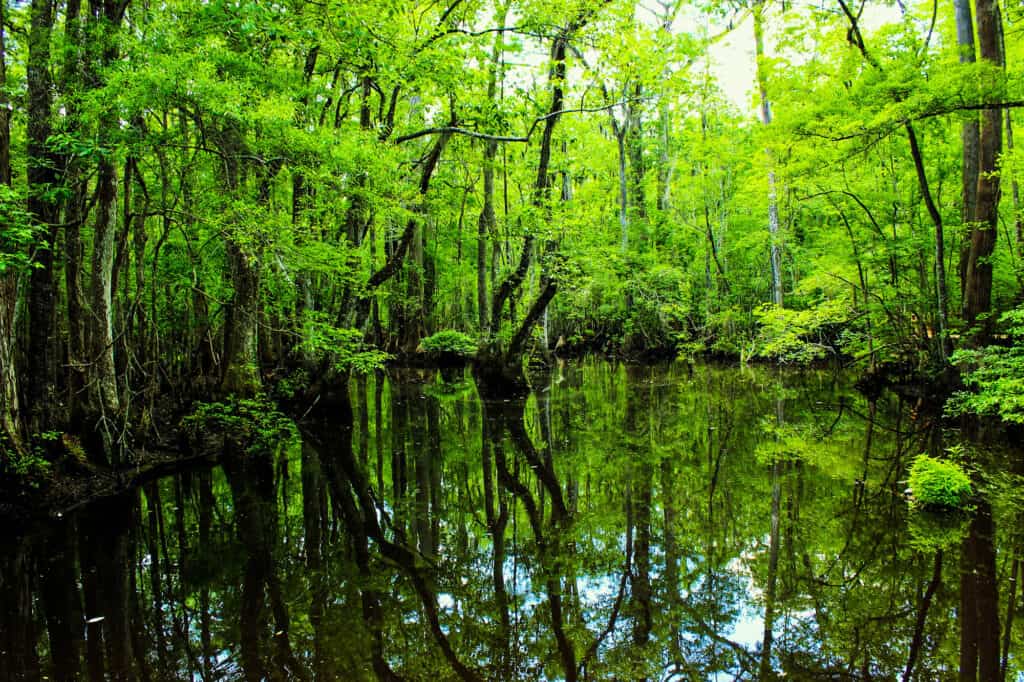
During the wet season, bottomland hardwood forests become inundated, prompting the trees to adapt and efficiently absorb oxygen while their roots are submerged.
©iStock.com/Rachel1221
Cypress-Tupelo Swamps
Cypress-tupelo swamps are extraordinary wetlands, distinguished by the dominant presence of two majestic tree species: bald cypress and water tupelo. These wetlands exhibit trees that possess remarkable adaptations, enabling them to flourish in damp and marshy environments. Cypress and tupelo trees have demonstrated exceptional adaptability to these unique circumstances, along with a diverse array of reptiles and amphibians, including alligators, snakes, and frogs.
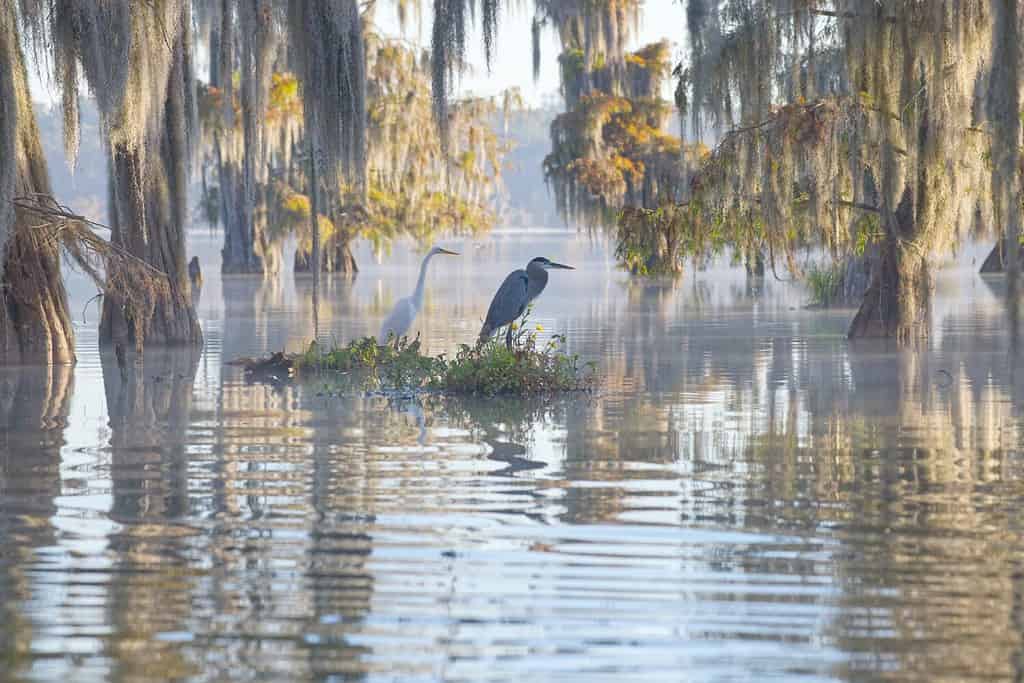
Many of the snakes living in the cypress-tupelo swamps along the Mississippi River serve as food items for large birds.
©Xiu Yu Photography/Shutterstock.com
Estuaries
Estuaries are coastal water bodies where the freshwater from the mighty Mississippi River merges with the saltwater of the Gulf of Mexico. These partially enclosed havens are brimming with a rich diversity of marine life, creating a vibrant ecosystem that thrives at this unique juncture. Estuaries form a transition zone between river environments and maritime environments.

Estuaries along the Mississippi provide an abundant assortment of fish and create an ecosystem that serves as a sanctuary for animals like
pelicans
,
ibises
, and snakes.
©Joanne Dale/Shutterstock.com
Snakes and the Mississippi River
The Mississippi River is an important wildlife corridor as we have just learned, providing a variety of habitats for a wide range of species and snakes. Being a major source of food and water for wildlife that snakes like to eat, the Mississippi River serves as a lifeline for many slithery creatures. Did you know that there are at least 12 different species of snakes that live along the Mississippi River?
Snakes living along the mighty Mississippi River include both venomous and non-venomous snakes. However, the exact number of snake species that live in or around the Mississippi River may vary depending on the time of year and the geographical location along the river’s edge. For example, the number of snake species in the upper Mississippi River may be different from the number of snake species thriving in the lower Mississippi River.
These are some of the most common snakes found thriving in either one or all four of the aforementioned ecosystems:
- Northern Watersnake
- Plain-Bellied Watersnake
- Eastern Copperhead
- Cottonmouth
- Timber Rattlesnake
- Eastern Hognose Snake
- Bullsnake
- Eastern Milksnake
- Eastern Yellow-Bellied Racer
- Northern Redbelly Snake
It is important to note that not all snakes found along the Mississippi River are dangerous. Some of the snakes, such as the northern watersnake and the eastern milksnake, are non-venomous and pose no threat to humans. However, snakes such as the eastern copperhead and the timber rattlesnake are venomous and can be dangerous if they bite.
If you are planning on spending time in the Mississippi River or its surrounding areas, it is important to be aware of the potential for snakes. Be sure to take precautions to avoid contact with snakes. Wear shoes and long pants, and avoid areas with dense vegetation. If you do see a snake, do not approach it and give it plenty of space.
Now, let’s take a look at some of the snakes living in the most snake-infested waters along the Mississippi River!
The Northern Watersnake
Northern watersnakes (Nerodia sipedon) are one of the most prevalent species of watersnakes in the United States. The northern watersnake likes to primarily inhabit watery environments such as streams, lakes, rivers, reservoirs, backyard ponds, and ditches.
Often mistaken for cottonmouths, northern watersnakes possess brown to gray bodies with white, yellow, and red hues. Their hefty frames can reach up to 6 feet in length, adorned with crossbands or blotches. However, while the northern watersnake glides just beneath the water’s surface, cottonmouth snakes generally like to float atop it.
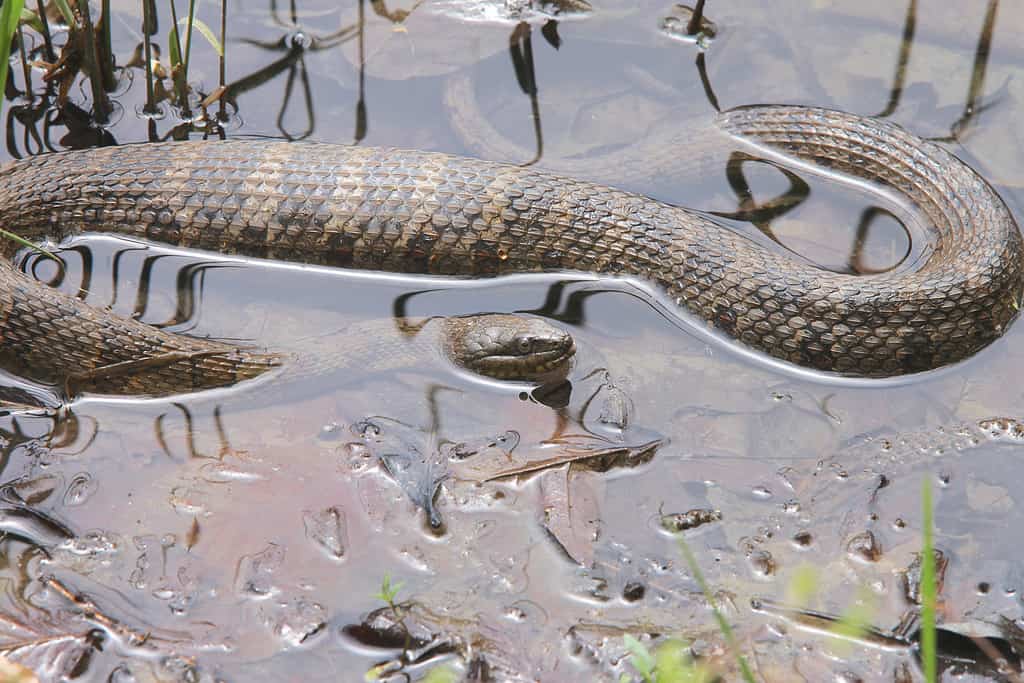
Northern watersnakes are non-venomous.
©iStock.com/NajaShots
The Plain-Bellied Watersnake
The plain-bellied watersnake (Nerodia erythrogaster) is a frequently encountered colubrid snake found exclusively within the United States. Its distinguishing feature is its plain belly, which gives rise to its common name, the plain-belly watersnake. Although plain-bellied watersnakes lack venom, they are not hesitant to bite when threatened. Moreover, they possess a musk gland located at the base of their tail, allowing them to exude an unpleasant odor as a form of defense.
Plain-bellied watersnakes are large, thick-bodied snakes. Adults can reach up to 48 inches in length from nose to tail. These creatures lack distinct patterns, with a consistent hue of gray, brown, or olive green on their backs. The ventral side displays a simple yellow or orange shade. When young, they display vibrant patterns with dark crossbands and blotches adorning their dorsal region. These agile snakes have exceptional swimming and diving abilities, often seeking solace on logs or branches within the water.
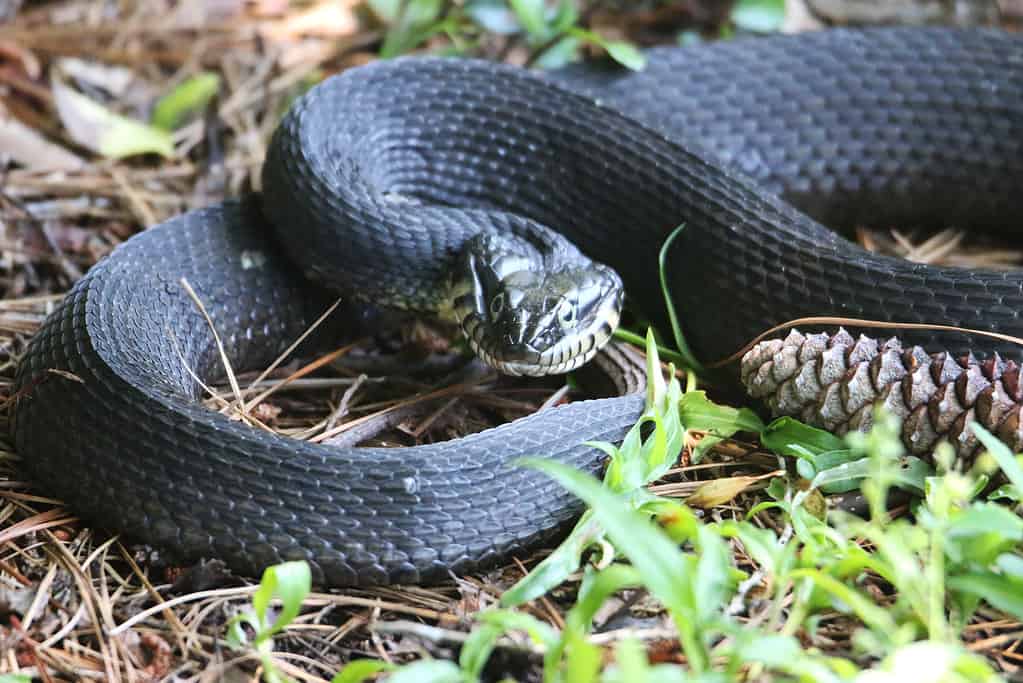
Plain-bellied watersnakes can be found in diverse aquatic habitats such as swamps, marshes, lakes, rivers, and ponds.
©iStock.com/lbolton09
The Eastern Copperhead
The eastern copperhead (Agkistrodon contortrix) is a venomous pit viper snake that naturally inhabits eastern North America. It holds the distinction of being one of the most prevalent venomous snakes found in the United States. Copperheads inhabit a diverse range of environments, ranging from forests and woodlands to swamps and rocky regions. These serpents are primarily active during the night, taking advantage of their nocturnal nature. Expert ambush predators, patiently await their prey, which typically includes rodents, lizards, and frogs.
Copperheads, though venomous, possess less potent venom compared to certain other pit vipers like rattlesnakes. And while copperhead snake bites are seldom deadly, they can induce pain, swelling, and bruising. If you are bitten by a copperhead, quickly seek medical attention.
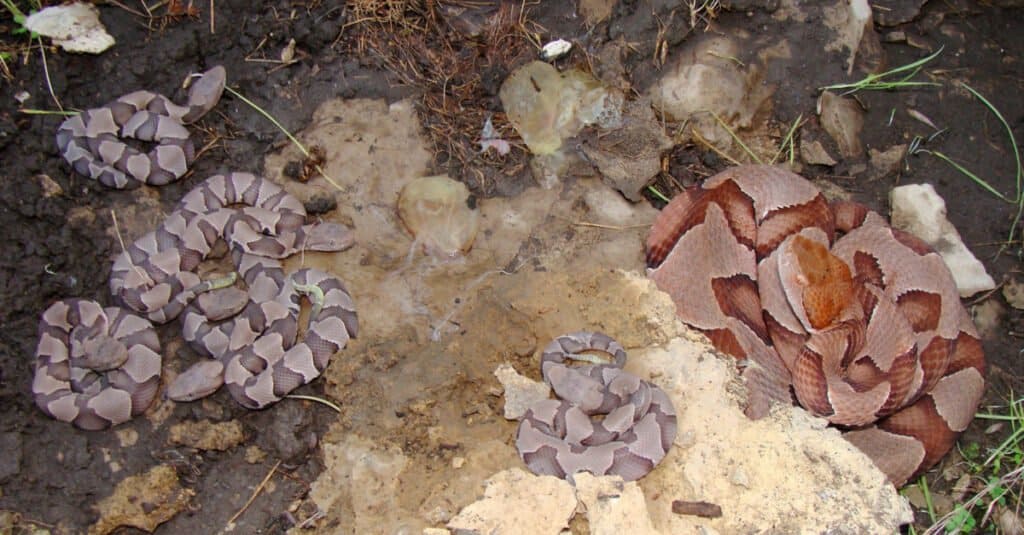
Copperhead babies may be small, but they are still venomous and can bite.
©Matt Jeppson/Shutterstock.com
The Cottonmouth
Cottonmouth snakes (Agkistrodon piscivorus) are medium to large snakes, usually growing between 2 and 4 feet long. Their body is sturdy with a triangular-shaped head. The scales on their back are brown or black with darker bands. The cottonmouth boasts a vibrant white color within its mouth, serving as a warning sign to predators that it has a dangerous nature. Cottonmouths are master ambush hunters, strategically positioning themselves along the water’s edge while waiting for their prey to come near. With lightning speed, they strike and inject venom through their fangs.
It is crucial to exercise caution and steer clear of this potentially dangerous reptile. The venom of the cottonmouth snake is hemotoxic. This means it causes significant damage to the victim’s blood cells. In certain cases, a bite from a cottonmouth can be fatal, emphasizing the seriousness of encountering this formidable reptile. Cottonmouth snakes, also known as water moccasins, are venomous pit vipers native to the southeastern United States.
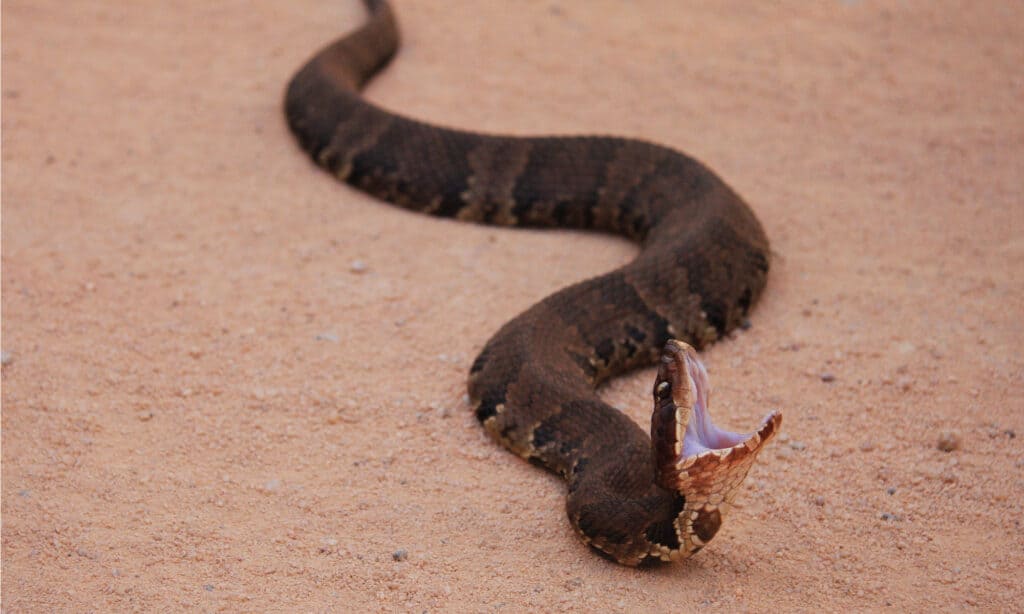
Cottonmouths are found in a variety of wetland habitats, including swamps, marshes, rivers, and lakes. They are also occasionally found in upland areas, such as forests and fields.
©Nathan A Shepard/Shutterstock.com
The Timber Rattlesnake
The timber rattlesnake (Crotalus horridus) also known as the canebrake rattlesnake, hails from the eastern United States. This venomous pit viper holds the title of being the largest rattlesnake in the region, measuring between 3 and 6 feet in length when fully grown. You can encounter timber rattlesnakes in diverse habitats like forests, fields, and swamps, but they particularly thrive in the Appalachian Mountains and along the Mississippi River.
Timber rattlesnakes exhibit both diurnal and nocturnal activity patterns. They consume a diverse array of prey, including rodents, rabbits, birds, and other snakes. Remarkably agile, they are adept climbers and proficient swimmers. Unlike constrictors, timber rattlesnakes incapacitate their prey by delivering a lethal injection of venom. Female timber rattlesnakes give birth to live offspring, typically numbering between four and 12 babies. They can live for 15 to 20 years.

Timber Rattlesnakes are extremely venomous but they are not aggressive.
©iStock.com/NajaShots
The Eastern Hognose Snake
The eastern hognose snake (Heterodon platirhinos) is a harmless snake species that inhabits the eastern United States, including the ecosystems that follow along the Mississippi River. Heterodon, meaning “different tooth”, denotes the presence of enlarged teeth at the back of the upper jaw. Their purpose is to inject a mild venom unique to targeting amphibians. The fangs acquire their venom from the Duvernoy’s gland within the snake. Although humans allergic to saliva may encounter localized swelling if bitten, no fatalities have been recorded as a result.
Measuring between 1 and 3 feet in length, this slender serpent has a stout body and a distinctively wide head. Its dorsal scales exhibit hues of brown, gray, or black, adorned by lighter markings that further accentuate its sleek appearance. Its belly presents an elegant white or cream-colored complexion of scales. Eastern hognose snakes live in sandy, gravelly soils in various environments such as open fields, river valleys, pine forests, and upland hillsides. As it primarily feeds on toads, it requires habitats like wetlands, marshes, swamps, and vernal pools that support the lives of amphibians.

There is a wide variety of colors and patterns exhibited by eastern hognose snakes
©IHX/Shutterstock.com
The Bullsnake
The bullsnake (Pituophis catenifer sayi), a subspecies of the gopher snake, is a sizable non-venomous serpent native to the United States and Canada. Bullsnakes are sizable serpents, typically measuring between 4 and 6 feet long. They possess a robust body accompanied by a triangular-shaped head. The dorsal scales exhibit shades of brown, gray, or black adorned with lighter markings. The ventral area showcases a vibrant hue of yellow or cream. They are frequently encountered in the rich tapestry of ecosystems sustained by the mighty Mississippi River, showcasing its remarkable diversity.
Bullsnakes will resort to biting if they sense they are in danger. Nonetheless, they possess a knack for putting on a show, so stay alert. When feeling threatened, a bullsnake may coil its body, emit a hiss, and even lunge at the perceived threat. However, it won’t sink its fangs. These clever serpents add to their spectacle by vibrating their tails and producing a rattling sound akin to that of a rattlesnake.
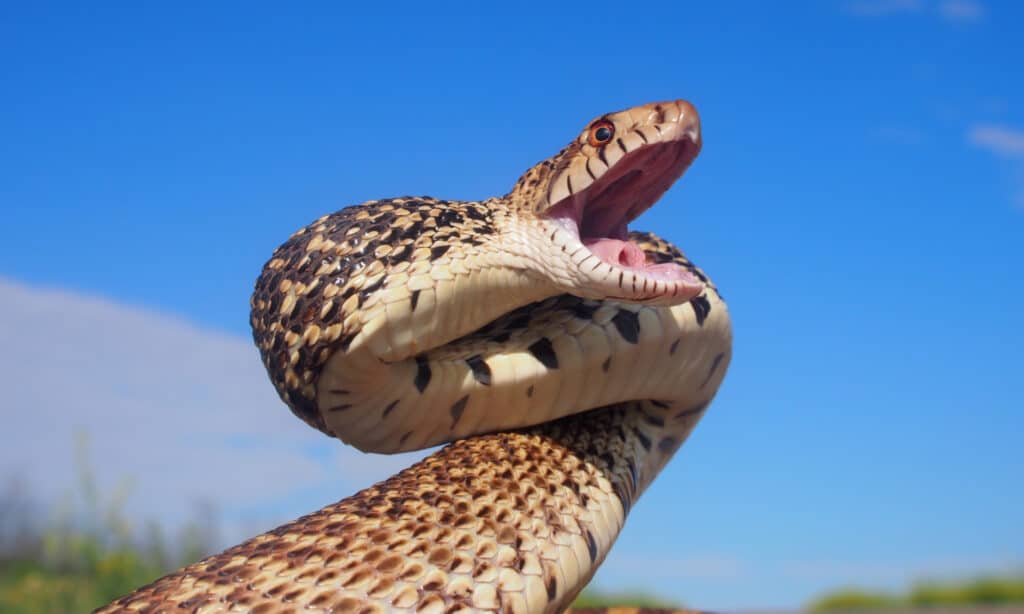
When threatened, the bullsnake rears up in an S-shape, hisses, and vibrates its tail to mimic the venomous rattlesnake.
©Markparker1983/Shutterstock.com
The Eastern Milksnake
The eastern milksnake (Lampropeltis triangulum triangulum) is a non-venomous snake that inhabits the eastern United States, including the regions along the mighty Mississippi River. The snake’s habitat ranges from forests and brushy areas to meadows. With a length typically ranging between 2 and 3 feet, this species is classified as a medium-sized snake. Its slender physique and unique triangular head display an array of captivating colors and patterns.
Eastern milksnakes are frequently misidentified as venomous snakes. But in reality, they are harmless and lack venom. Eastern milksnakes are versatile predators, known for their opportunistic feeding habits. They consume a diverse range of prey, such as rodents, frogs, lizards, and even other snakes. Utilizing their constricting abilities, these snakes skillfully coil their bodies around their prey, ultimately suffocating them.
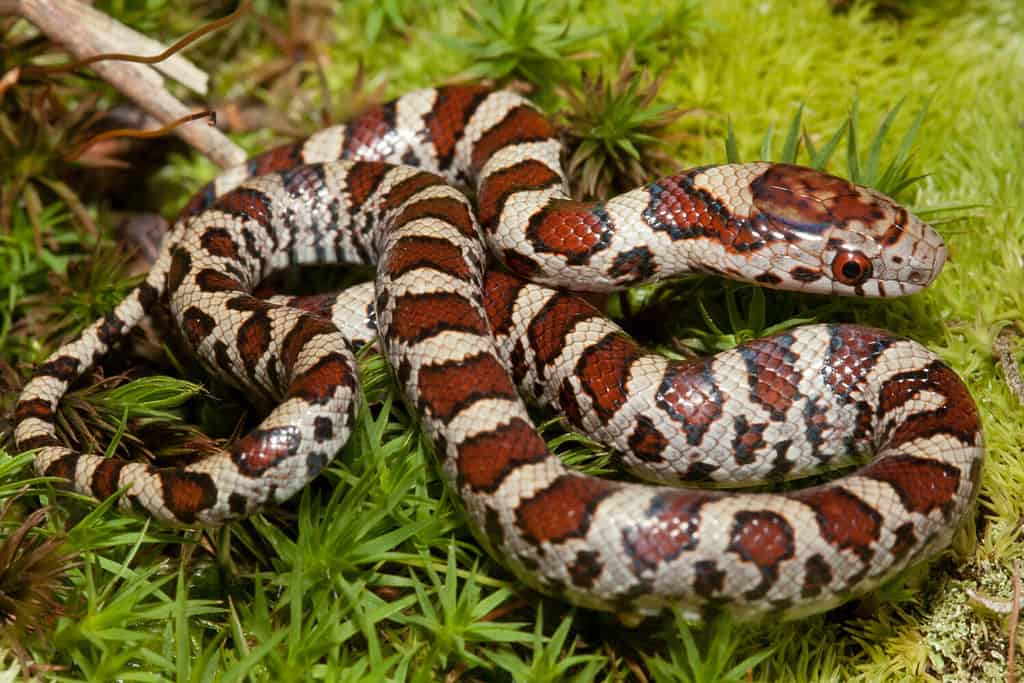
Eastern milksnakes live for 10-15 years, adding charm and beauty to their surroundings.
©Nathan A Shepard/Shutterstock.com
The Eastern Yellow-Bellied Racer
The eastern yellow-bellied racer (Coluber constrictor flaviventris) is a harmless snake indigenous to the eastern United States, including areas along the Mississippi River. Possessing a sleek physique and elongated tail, this medium-sized reptile usually reaches lengths of 2 to 4 feet.
Eastern yellow-bellied racers are highly agile serpents with exceptional climbing abilities. They are active both during the day and night, thriving in diverse environments such as forests, fields, and swamps, referring to environments abundant with rocky outcrops. Eastern-bellied racers are carnivorous reptiles that consume small creatures such as rodents, lizards, frogs, and birds. These serpents possess the remarkable ability to constrict their prey, expertly coiling their slender bodies around them to effectively suffocate their prey victims. While not venomous, they do have the potential to bite if they perceive a threat.
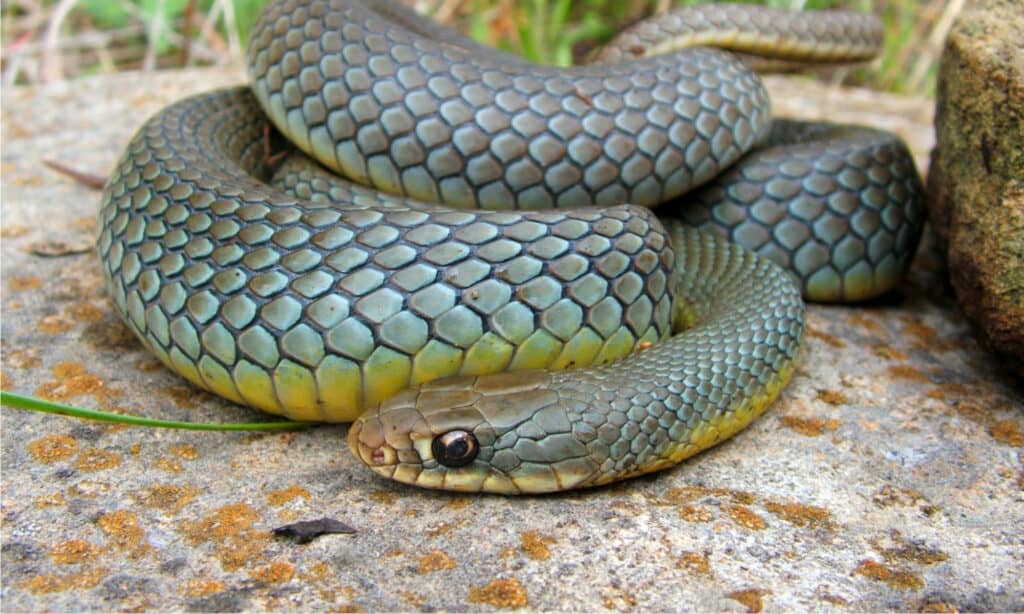
Although the bite of an eastern yellow-bellied racer isn’t particularly harmful to humans, it can certainly cause discomfort.
©Matt Jeppson/Shutterstock.com
The Northern Redbelly Snake
The eastern United States is home to a fascinating serpent known as the northern redbelly snake (Storeria occipitomaculata occipitomaculata). This diminutive, non-venomous creature can be found slithering along the banks of the Mississippi River. Measuring between 8 and 12 inches, these sleek and elegant reptiles possess a slender physique and are adorned with brown, gray, or black scales accentuated by lighter markings. Perhaps most notably, their vibrant red or orange belly provides a striking contrast to the rest of their appearance.
Northern redbelly snakes, as insectivores, consume a diverse array of creepy crawlers such as beetles, crickets, and grasshoppers. Additionally, they exhibit an appetite for small snails and slugs. Active throughout the day and night, these serpents inhabit a range of environments including forests, fields, and swamps, with a preference for moist locales.
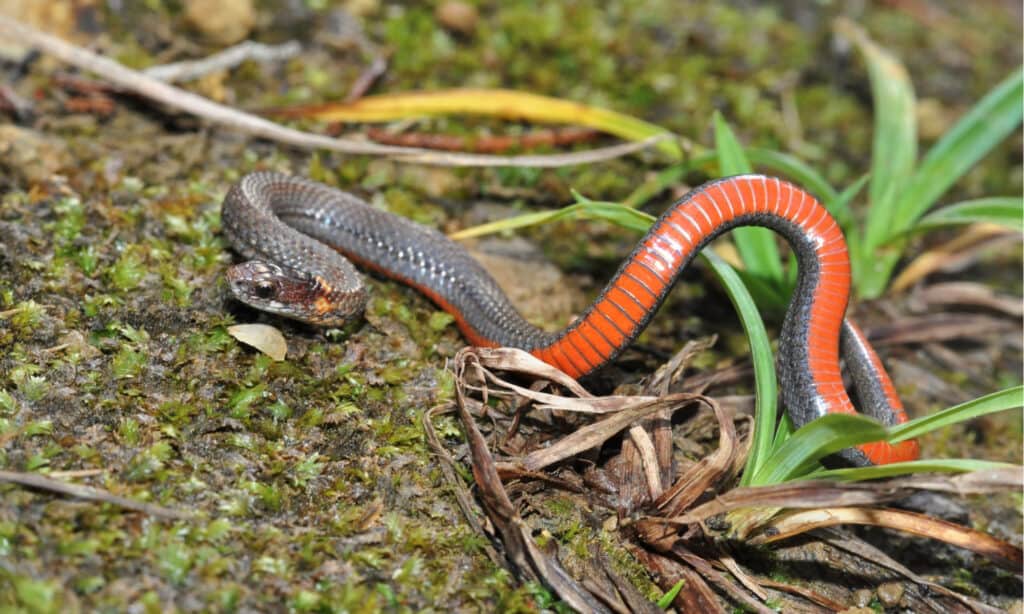
The tops of their bodies are plain, but redbelly snakes have startling colorful bellies.
©Mike Wilhelm/Shutterstock.com
Snake Bites and the Mississippi River
Snake bites are frequent near the Mississippi River during the spring and summer seasons when snakes exhibit heightened activity levels. The presence of water and vegetation alongside the river’s edge attracts the critters and small mammals that snakes like to eat; that, combined with tourism and recreational summer activities, increases the likelihood of encounters with humans during the spring and summer periods.
Arkansas, Mississippi, and Louisiana frequently report some of the most snake bite incidents and are thought to be among the most snake-infested locations along the mighty Mississippi. Among the venomous snakes found in Arkansas, the timber rattlesnake, copperhead, and cottonmouth are the most prevalent species. The most common venomous snakes in Louisiana are the cottonmouth, the western diamondback rattlesnake, and the copperhead. And in Mississippi, the most common venomous snakes are the timber rattlesnake, the copperhead, and the cottonmouth.
So, when venturing into the great outdoors along the majestic Mississippi River for activities like hiking, camping, or fishing, it’s vital to stay mindful of the potential dangers posed by snake bites. Taking necessary precautions and being vigilant can help prevent unwanted encounters. Be aware of areas in which venomous snakes may live, such as near water sources or among rocks and dense vegetation. Additionally, wearing protective clothing and boots can help protect you from potential bites.
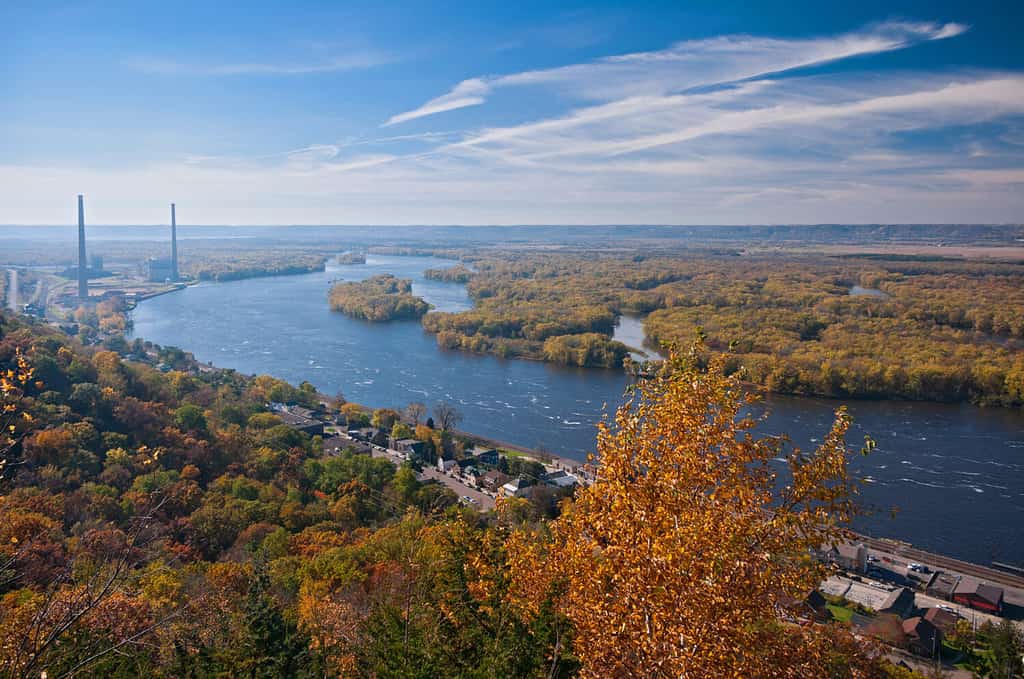
Snakes in and around the Mississippi River are not aggressive, but if they feel threatened or if you surprise them, they will defend themselves and possibly bite.
©Joe Ferrer/Shutterstock.com
The Future of the Mississippi River and Its Snake-Infested Waters
The Mississippi River is facing a range of imminent threats such as pollution, habitat depletion, and climate change. These formidable challenges have a negative the urgent need to take proactive measures to protect and preserve the habitats of the Mississippi River and ensure the overall well-being of the river itself. Conservation efforts, such as protecting riparian zones and floodplains to limit erosion and habitat destruction, are essential for maintaining a healthy river system.
Additionally, public awareness campaigns aimed at reducing pollution can help reduce the amount of waste entering the river from both industrial sources and individuals. The establishment of protected areas along the banks of the Mississippi River can also provide vital habitat for wildlife species, especially snakes, an important keystone species in this ecosystem.
The photo featured at the top of this post is © John Brueske/Shutterstock.com
Discover the "Monster" Snake 5X Bigger than an Anaconda
Every day A-Z Animals sends out some of the most incredible facts in the world from our free newsletter. Want to discover the 10 most beautiful snakes in the world, a "snake island" where you're never more than 3 feet from danger, or a "monster" snake 5X larger than an anaconda? Then sign up right now and you'll start receiving our daily newsletter absolutely free.
Thank you for reading! Have some feedback for us? Contact the AZ Animals editorial team.







